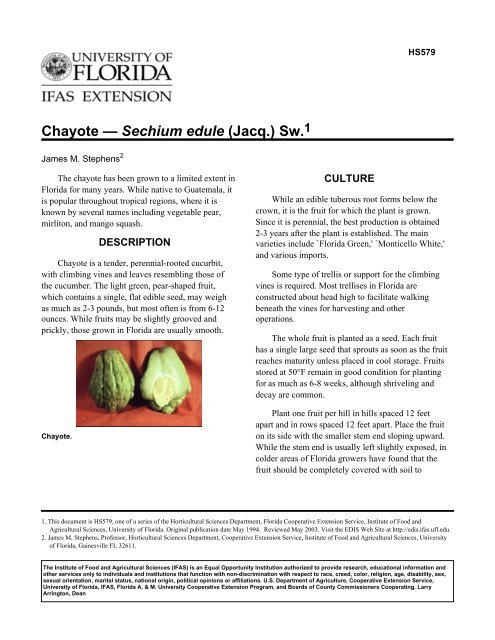Chayote — Sechium edule (Jacq.) Sw. - Orange County Extension ...
Chayote — Sechium edule (Jacq.) Sw. - Orange County Extension ...
Chayote — Sechium edule (Jacq.) Sw. - Orange County Extension ...
You also want an ePaper? Increase the reach of your titles
YUMPU automatically turns print PDFs into web optimized ePapers that Google loves.
<strong>Chayote</strong> <strong>—</strong> <strong>Sechium</strong> <strong>edule</strong> (<strong>Jacq</strong>.) <strong>Sw</strong>. 1<br />
James M. Stephens 2<br />
The chayote has been grown to a limited extent in<br />
Florida for many years. While native to Guatemala, it<br />
is popular throughout tropical regions, where it is<br />
known by several names including vegetable pear,<br />
mirliton, and mango squash.<br />
DESCRIPTION<br />
<strong>Chayote</strong> is a tender, perennial-rooted cucurbit,<br />
with climbing vines and leaves resembling those of<br />
the cucumber. The light green, pear-shaped fruit,<br />
which contains a single, flat edible seed, may weigh<br />
as much as 2-3 pounds, but most often is from 6-12<br />
ounces. While fruits may be slightly grooved and<br />
prickly, those grown in Florida are usually smooth.<br />
<strong>Chayote</strong>.<br />
CULTURE<br />
HS579<br />
While an edible tuberous root forms below the<br />
crown, it is the fruit for which the plant is grown.<br />
Since it is perennial, the best production is obtained<br />
2-3 years after the plant is established. The main<br />
varieties include `Florida Green,' `Monticello White,'<br />
and various imports.<br />
Some type of trellis or support for the climbing<br />
vines is required. Most trellises in Florida are<br />
constructed about head high to facilitate walking<br />
beneath the vines for harvesting and other<br />
operations.<br />
The whole fruit is planted as a seed. Each fruit<br />
has a single large seed that sprouts as soon as the fruit<br />
reaches maturity unless placed in cool storage. Fruits<br />
stored at 50°F remain in good condition for planting<br />
for as much as 6-8 weeks, although shriveling and<br />
decay are common.<br />
Plant one fruit per hill in hills spaced 12 feet<br />
apart and in rows spaced 12 feet apart. Place the fruit<br />
on its side with the smaller stem end sloping upward.<br />
While the stem end is usually left slightly exposed, in<br />
colder areas of Florida growers have found that the<br />
fruit should be completely covered with soil to<br />
1. This document is HS579, one of a series of the Horticultural Sciences Department, Florida Cooperative <strong>Extension</strong> Service, Institute of Food and<br />
Agricultural Sciences, University of Florida. Original publication date May 1994. Reviewed May 2003. Visit the EDIS Web Site at http://edis.ifas.ufl.edu.<br />
2. James M. Stephens, Professor, Horticultural Sciences Department, Cooperative <strong>Extension</strong> Service, Institute of Food and Agricultural Sciences, University<br />
of Florida, Gainesville FL 32611.<br />
The Institute of Food and Agricultural Sciences (IFAS) is an Equal Opportunity Institution authorized to provide research, educational information and<br />
other services only to individuals and institutions that function with non-discrimination with respect to race, creed, color, religion, age, disability, sex,<br />
sexual orientation, marital status, national origin, political opinions or affiliations. U.S. Department of Agriculture, Cooperative <strong>Extension</strong> Service,<br />
University of Florida, IFAS, Florida A. & M. University Cooperative <strong>Extension</strong> Program, and Boards of <strong>County</strong> Commissioners Cooperating. Larry<br />
Arrington, Dean
<strong>Chayote</strong> <strong>—</strong> <strong>Sechium</strong> <strong>edule</strong> (<strong>Jacq</strong>.) <strong>Sw</strong>. 2<br />
protect the bud from early cold damage. Plant in the<br />
early spring in all areas of Florida, and/or in the fall<br />
in South Florida.<br />
Fertilizer should be applied in three applications:<br />
at planting time, in the middle of the summer, and<br />
when fruits are small. Fertilizing at more frequent<br />
intervals might be necessary when conditions<br />
warrant. Well rotted animal manures or composted<br />
materials are beneficial.<br />
Both male and female flowers occur on the same<br />
vine. These flowers are visited by insects, both wasps<br />
and bees, which facilitate pollination. Fruits mature<br />
about 35 days following pollination.<br />
USE<br />
<strong>Chayote</strong> is served in many ways: creamed,<br />
buttered, fried, stuffed, baked, frittered, boiled,<br />
mashed, pickled, in salads, or in pies. Commercially,<br />
the biggest market appears to be for pickling.<br />
Following harvest the fruits may be stored in<br />
edible condition for several weeks if wrapped in<br />
newspaper and kept cool (50-55°F). At room<br />
temperature, the fruit will shrivel and sprout.

















